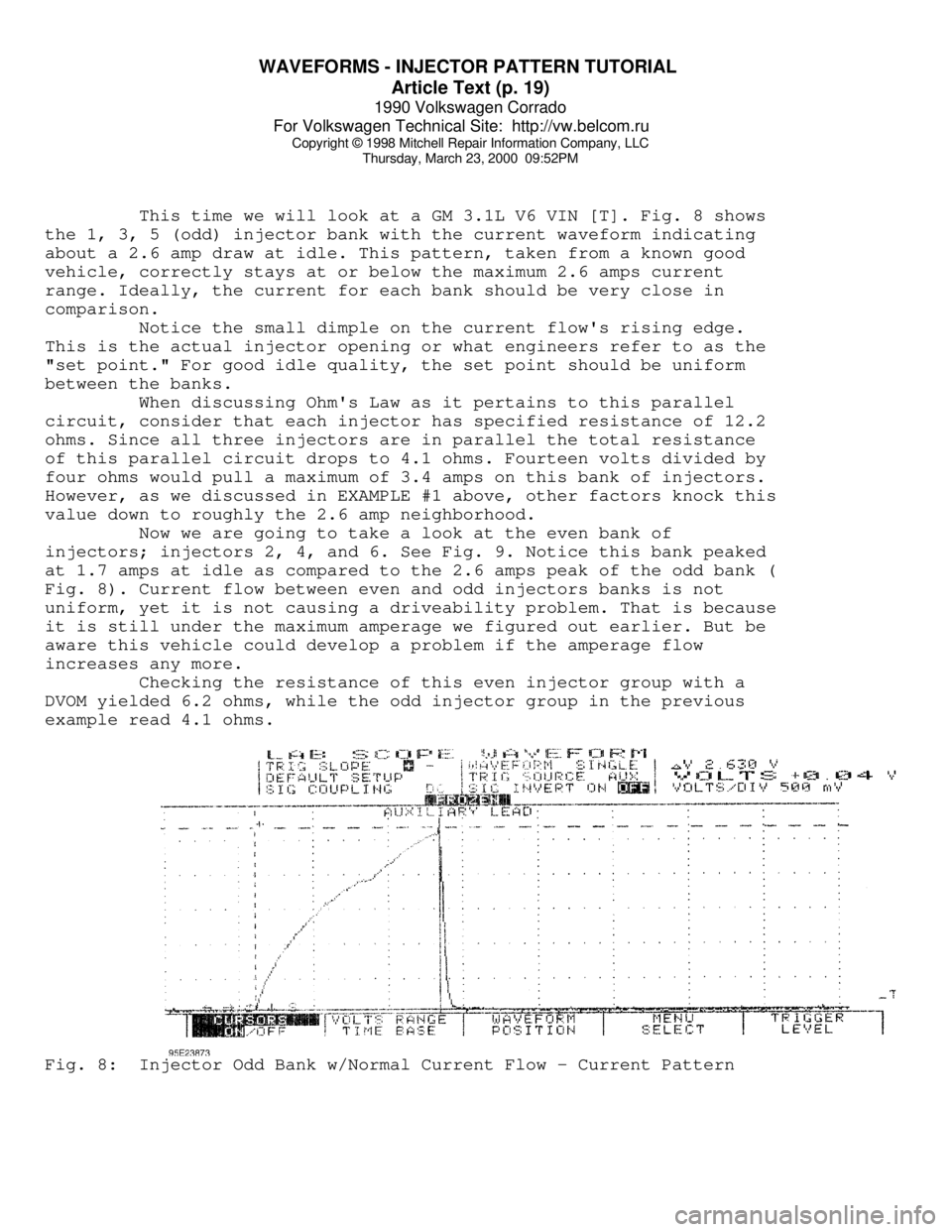1990 VOLKSWAGEN CORRADO hood open
[x] Cancel search: hood openPage 350 of 906

A/C SYSTEM GENERAL DIAGNOSTIC PROCEDURES
Article Text (p. 2)
1990 Volkswagen Corrado
For Volkswagen Technical Site: http://vw.belcom.ru
Copyright © 1998 Mitchell Repair Information Company, LLC
Thursday, March 23, 2000 09:41PM
5000 ........................ 24.92 ......................... +5.0
6000 ........................ 23.92 ......................... +6.0
7000 ........................ 23.02 ......................... +6.9
8000 ........................ 22.22 ......................... +7.7
9000 ........................ 21.32 ......................... +8.6
10,000 ...................... 20.52 ......................... +9.4
(1) - Add correction shown to gauge readings.ÄÄÄÄÄÄÄÄÄÄÄÄÄÄÄÄÄÄÄÄÄÄÄÄÄÄÄÄÄÄÄÄÄÄÄÄÄÄÄÄÄÄÄÄÄÄÄÄÄÄÄÄÄÄÄÄÄÄÄÄÄÄÄÄÄÄÄÄÄÄ PREPARATION FOR TESTING
1) Attach Low and High pressure gauges.
2) Start engine and allow to warm up.
3) Set system to "COOL" and blower to "HIGH".
4) Open car doors and hood.
5) Run engine at fast idle for 2-3 minutes.
AIR CONDITIONING SYSTEM PERFORMANCE CHECK TABLE
ÄÄÄÄÄÄÄÄÄÄÄÄÄÄÄÄÄÄÄÄÄÄÄÄÄÄÄÄÄÄÄÄÄÄÄÄÄÄÄÄÄÄÄÄÄÄÄÄÄÄÄÄÄÄÄÄÄÄÄÄÄÄÄÄÄÄÄÄÄPERFORM TESTS: SHOULD BE: IF:
ÄÄÄÄÄÄÄÄÄÄÄÄÄÄÄÄÄÄÄÄÄÄÄÄÄÄÄÄÄÄÄÄÄÄÄÄÄÄÄÄÄÄÄÄÄÄÄÄÄÄÄÄÄÄÄÄÄÄÄÄÄÄÄÄÄÄÄÄÄTemperature Check Temperature Check Is
* Switch to "LOW" blower.
* Close doors.
* Check outlet temperature. 35-45
ø F Too warm - Check control
lever operation, heater
water valve, cooling
system and gauge
readings.
ÄÄÄÄÄÄÄÄÄÄÄÄÄÄÄÄÄÄÄÄÄÄÄÄÄÄÄÄÄÄÄÄÄÄÄÄÄÄÄÄÄÄÄÄÄÄÄÄÄÄÄÄÄÄÄÄÄÄÄÄÄÄÄÄÄÄÄÄÄÄVisual Check Visual Check Shows:
* Compressor Quiet, No Leaks Noisy - Check belts, oil
level, seals, gaskets,
reed valves.
* Condenser Free of Obstructions Blocked - Clean off.
Plugged - Flush or
replace.
* Receiver-Drier Dry & warm to touch Frosty - Check for
restriction, replace
desiccant.
* Sight Glass Clear or few bubbles Bubbly, foamy or streaks
- Check gauge readings.
* High Side Lines Dry & warm to touch Frosty or very hot -
Check for restriction or
overcharge.
* Low Side Lines Dry & cool to touch Frosty or warm - Check
for restriction, low
charge or bad valve.
* Expansion Valve Dry Frosty - Check for
Page 456 of 906

E - THEORY/OPERATION - DIGIFANT
Article Text (p. 6)
1990 Volkswagen Corrado
For Volkswagen Technical Site: http://vw.belcom.ru
Copyright © 1998 Mitchell Repair Information Company, LLC
Thursday, March 23, 2000 09:43PM
element and the power steering pressure switch.
FUEL PRESSURE REGULATOR
The fuel pressure regulator is a sealed, spring loaded
diaphragm with connection for intake manifold vacuum. Fuel pressure is
maintained at about 36 psi (2.5 kg/cmý) pressure.
A connection for intake manifold vacuum provides a constant
pressure differential which ensures that the amount of fuel injected
is solely dependent upon injector open ON time. Excess fuel is
returned to fuel tank. No service of pressure regulator is required.
The pressure regulator is located on or near fuel rail.
FUEL CONTROL
Data on engine temperature, engine speed, intake air volume,
throttle position, exhaust oxygen content and intake air temperature
are used by ECM to determine injection pulse width.
FUEL INJECTORS
A fuel rail links the fuel pressure regulator with the fuel
injectors. Each cylinder is provided with a solenoid-operated injector
which sprays fuel toward backside of each inlet valve. Each injector
is energized through the ignition coil and grounded through the ECU to
complete the circuit
Each injector is linked to a resistor (resistor may be
external or integral with injector or ECU) to reduce operating voltage
to 3 volts and to protect injectors from power surges. The ECU
controls length of time each injector is open. The ON time of the
injector governs the amount of fuel delivered. The injector delivers
1/2 the amount of fuel required for an operating cycle each time they
open (twice per cycle).
FUEL PUMP AFTER-RUN RELAY (CORRADO)
The purpose of the After-Run Fuel Pump relay system is to
reduce the chance of fuel vaporizing in fuel rail. Both transfer pump
and fuel pump are used to recirculate fuel. The after-run relay
switches the pumps on for 2 minutes after ignition is turned off or
when under hood temperature exceeds 194
ø F (90ø C) and fuel pressure
is above 17 psi (1.2 kg/cm
ý). The pumps operate a maximum of 8
minutes.
IDLE SPEED
Engine idle speed is controlled by the ECU and idle speed
control unit depending upon engine operating conditions. The ECU and
Idle speed control unit are fed information on engine operating
conditions and determine the best idle speed.
IDLE AIR STABILIZER VALVE
Page 863 of 906

WAVEFORMS - INJECTOR PATTERN TUTORIAL
Article Text (p. 19)
1990 Volkswagen Corrado
For Volkswagen Technical Site: http://vw.belcom.ru
Copyright © 1998 Mitchell Repair Information Company, LLC
Thursday, March 23, 2000 09:52PM
This time we will look at a GM 3.1L V6 VIN [T]. Fig. 8 shows
the 1, 3, 5 (odd) injector bank with the current waveform indicating
about a 2.6 amp draw at idle. This pattern, taken from a known good
vehicle, correctly stays at or below the maximum 2.6 amps current
range. Ideally, the current for each bank should be very close in
comparison.
Notice the small dimple on the current flow's rising edge.
This is the actual injector opening or what engineers refer to as the
"set point." For good idle quality, the set point should be uniform
between the banks.
When discussing Ohm's Law as it pertains to this parallel
circuit, consider that each injector has specified resistance of 12.2
ohms. Since all three injectors are in parallel the total resistance
of this parallel circuit drops to 4.1 ohms. Fourteen volts divided by
four ohms would pull a maximum of 3.4 amps on this bank of injectors.
However, as we discussed in EXAMPLE #1 above, other factors knock this
value down to roughly the 2.6 amp neighborhood.
Now we are going to take a look at the even bank of
injectors; injectors 2, 4, and 6. See Fig. 9. Notice this bank peaked
at 1.7 amps at idle as compared to the 2.6 amps peak of the odd bank (
Fig. 8). Current flow between even and odd injectors banks is not
uniform, yet it is not causing a driveability problem. That is because
it is still under the maximum amperage we figured out earlier. But be
aware this vehicle could develop a problem if the amperage flow
increases any more.
Checking the resistance of this even injector group with a
DVOM yielded 6.2 ohms, while the odd injector group in the previous
example read 4.1 ohms.Fig. 8: Injector Odd Bank w/Normal Current Flow - Current Pattern
Page 888 of 906

WIPER/WASHER SYSTEM
Article Text (p. 2)
1990 Volkswagen Corrado
For Volkswagen Technical Site: http://vw.belcom.ru
Copyright © 1998 Mitchell Repair Information Company, LLC
Thursday, March 23, 2000 09:53PMÄÄÄÄÄÄÄÄÄÄÄÄÄÄÄÄÄÄÄÄÄÄÄÄÄÄÄÄÄÄÄÄÄÄÄÄÄÄÄÄÄÄÄÄÄÄÄÄÄÄÄÄÄÄÄ TESTING
Testing information is not available from manufacturer.
FRONT WIPER MOTOR R & I
Removal (Cabriolet & Passat)
Open hood, and unplug wiring connector. Pry linkage off motor
crank arm. Remove 4 bolts and motor. DO NOT remove motor bracket when
removing motor.
Installation
Check crank arm alignment by running motor and allowing arm
to park. Crank arm should be at 20-degree angle to motor centerline.
See Fig. 1. To complete installation, reverse removal procedure,
installing left linkage rod first.
Removal & Installation (Corrado & Fox)
For removal and installation of wiper motor and components,
refer to illustration. See Fig. 2.
Removal (Golf, GTI & Jetta)
Remove connecting linkage from motor crank arm. Unplug wiring
connector. Mark position of wiper motor crank arm. Remove wiper motor
crank arm and 3 mounting bolts. Slide motor out from beneath bracket,
and remove motor.
Installation
Check crank arm alignment by running motor and allowing arm
to park. Crank arm should be in line with motor centerline and linkage
ball should point from motor. See Fig. 1. Reverse removal procedure to
complete installation.
Removal (Vanagon)
Remove wipers, arms and shaft nuts. Remove glove box and
instrument cluster. Remove wiper linkage rods by extending fully to
passenger side. Unplug wiring connector. Remove wiper bracket bolts
and bracket. Remove crank arm, 3 bolts and wiper motor.
Installation
Connect motor wiring, run motor and allow arm to park. Align
crank arm and linkage rod as shown. See Fig. 1. Reverse removal
procedure to install.